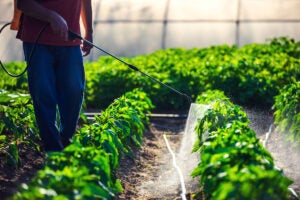AGDAILY and its parent company were paid a fee to publish this article unedited. The views or opinions expressed here are those of the author and may not reflect those of AGDAILY or any of its affiliates.
Sustainability — it’s a hot topic across various industries, fertilizer manufacturing being no exception. Global soil depletion and our volatile climate situation have prompted many organizations to develop more sophisticated food production methods.
Among the many options for plant nutrition, gel fertilizers stand out as some of the smartest products available on the market today.
But what exactly makes them so special? How do they benefit growers, and what role do they play in promoting sustainable food production? In this article, we’ll dig into these questions.
What are Gel Fertilizers?
Gel fertilizers, otherwise known as hydrogels, are composed of small, water-absorbent polymers, such as polyacrylamide or polyacrylate. They’re capable of retaining hundreds of times their mass in water. When mixed with soil or directly applied to a plant, these polymer crystals store moisture, releasing it slowly over time.
While the idea of using hydrogels in agriculture has been around since the mid-20th century, it’s only in recent years that these products have gained mainstream popularity.
The appeal of this novel approach to fertilization is that it tackles many of the common pitfalls of granular or liquid formulations. Despite their widespread usage, dry nitrogen-based products can cause uneven uptake, leaching, and runoff. In contrast, gels are just as potent, but with a significantly reduced environmental impact.
Ingredients and Formulation
So what is gel fertilizer made of? Like all other fertilizer types, gels carry multiple nutrients to support plant health and vigor. This is usually a balanced blend of macronutrients such as nitrogen (N), phosphorus (P), and potassium (K), along with other chelated micronutrients and trace elements.
It’s also not uncommon for gel fertilizers to contain several other beneficial biostimulants, most commonly seaweed extracts, amino acids, fulvic, and humic acids.
Fortunately, this means there’s a suitable nutrient mix available for almost any plant type. The exact NPK ratio you’ll need will depend on the specific requirements of different crops and soil conditions.
Slow-Release Mechanism
One of the standout features of gel fertilizers is their slow-release mechanism. While traditional products often provide a quick but short-lived burst of nutrients, gels are specifically engineered to deliver nutrients to plants gradually.
Most importantly, this unique mechanism reduces the need for frequent applications. Once delivered to a field, the water-absorbent polymers retain moisture and swell, forming a gel-like matrix. Over time, water and nutrients are steadily released from this reservoir into the surrounding soil.
Thanks to this refined process, gel fertilizers have been shown to reduce the risk of leaching by up to 45%. Not only that, but gels can improve soil structure and aeration, which helps roots grow strong and sturdy. This is especially beneficial for plants that require consistent watering, such as seedlings, potted plants, and hanging baskets.
Keep in mind that crop nutrition isn’t as simple as it sounds. Fertilization can have negative consequences too, if not managed correctly. Not enough nutrients can lead to stunted growth, while overapplication often causes damage to plants and the environment. That’s why this controlled-release mechanism is one of the biggest gel fertilizer benefits.
Applications of Gel Fertilizers

Once you know the exact nutritional requirements of your crops, choosing and using gel fertilizers is a fairly straightforward process. Most growers choose gel formulations because of their effectiveness with two main application methods: fertigation and foliar sprays.
Drip fertigation, or distributing fertilizer through irrigation systems, is particularly beneficial in water-scarce regions. When integrated into such systems, the slow-release properties of gel fertilizers kick in to supply dry fields with a sustained amount of water and nutrients.
Foliar application, on the other hand, is mostly used as a form of complementary nutrition when soil fertilization is insufficient. Sometimes unpredictable weather conditions can impair root uptake. Thankfully, a mid-season foliar spray can quickly correct many symptoms of NPK deficiencies.
Well-timed gel fertilizer applications can also induce various beneficial physiological processes in plants, such as dormancy breaking or flowering. Simply dilute the water-soluble gel and directly spray it onto the leaves of the plants. Avoiding windy conditions and spraying during cooler, humid hours is recommended.
Benefits of Using Gel Fertilizers
We covered the basic qualities of gel fertilizers, but what exactly makes them such a promising alternative to conventional plant nutrition? Although other products continue to dominate the market, gel formulations have several major advantages that they bring to the table:
- An eco-friendly fertilization solution that has a smaller carbon footprint compared to traditional products.
- Gel formulations excel in arid conditions with nutrient-depleted soils that require more frequent watering.
- Gel fertilizers can improve soil composition and promote healthy microorganism activity.
- Suitable for a large variety of crops, including high-value fruits, vegetables, and ornamental plants.
- Ideal for precise nutrient management, especially in greenhouse settings and container gardening.
- While they may be more expensive upfront, gel fertilizers drastically reduce application frequency, making them more cost-effective in the long run.
Gel fertilizers exhibit remarkable versatility in agricultural applications, as they can seamlessly accommodate the incorporation of various additives such as insecticides or anti-transpirant plant conditioners. This compatibility allows for the simultaneous delivery of nutrients along with targeted treatments, enhancing overall plant health and resilience.
Conclusion
To wrap it up, it’s evident that gel fertilizers are a step in the right direction in our global pursuit of greener solutions. However, the adoption of sustainable farming practices is a gradual process. It will take several decades for emerging products and technologies to establish themselves as the primary method of crop production. Until then, gels remain in the specialty fertilizers category, a promising addition to our effort to reduce humanity’s carbon footprint.


